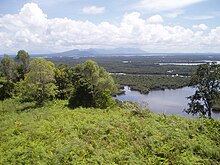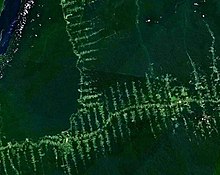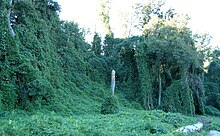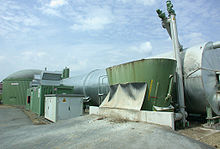This coral reef in the Phoenix Islands Protected Area is a rich habitat for sea life.
Few creatures make the ice shelves of Antarctica their habitat.
Ibex in alpine habitat
In ecology, a habitat is the type of natural environment in which a particular species of organism
lives. It is characterized by both physical and biological features. A
species' habitat is those places where it can find food, shelter,
protection and mates for reproduction.
The physical factors are for example soil, moisture, range of temperature, and light intensity as well as biotic factors such as the availability of food and the presence or absence of predators.
Every organism has certain habitat needs for the conditions in which it
will thrive, but some are tolerant of wide variations while others are
very specific in their requirements. A habitat is not necessarily a
geographical area, it can be the interior of a stem, a rotten log, a
rock or a clump of moss, and for a parasitic organism it is the body of its host, part of the host's body such as the digestive tract, or a single cell within the host's body.
Habitat types include polar, temperate, subtropical and tropical. The terrestrial vegetation type may be forest, steppe, grassland, semi-arid or desert. Fresh water habitats include marshes, streams, rivers, lakes, ponds and estuaries, and marine habitats include salt marshes, the coast, the intertidal zone, reefs, bays, the open sea, the sea bed, deep water and submarine vents.
Habitats change over time. This may be due to a violent event such as the eruption of a volcano, an earthquake, a tsunami, a wildfire or a change in oceanic currents; or the change may be more gradual over millennia with alterations in the climate, as ice sheets and glaciers advance and retreat, and as different weather patterns bring changes of precipitation and solar radiation. Other changes come as a direct result of human activities; deforestation,
the ploughing of ancient grasslands, the diversion and damming of
rivers, the draining of marshland and the dredging of the seabed. The introduction of alien species can have a devastating effect on native wildlife, through increased predation,
through competition for resources or through the introduction of pests
and diseases to which the native species have no immunity.
Definition and etymology
The word "habitat" has been in use since about 1755 and derives from the Latin habitāre, to inhabit, from habēre, to have or to hold. Habitat can be defined as the natural environment of an organism, the type of place in which it is natural for it to live and grow. It is similar in meaning to a biotope; an area of uniform environmental conditions associated with a particular community of plants and animals.
Environmental factors
The
chief environmental factors affecting the distribution of living
organisms are temperature, humidity, climate, soil type and light
intensity, and the presence or absence of all the requirements that the
organism needs to sustain it. Generally speaking, animal communities are
reliant on specific types of plant communities.
Some plants and animals are generalists, and their habitat requirements are met in a wide range of locations. The small white butterfly (Pieris rapae) for example is found on all the continents of the world apart from Antarctica. Its larvae feed on a wide range of Brassicas and various other plant species, and it thrives in any open location with diverse plant associations.
The large blue butterfly is much more specific in its requirements; it
is found only in chalk grassland areas, its larvae feed on Thymus species and because of complex lifecycle requirements it inhabits only areas in which Myrmica ants live.
Disturbance is important in the creation of biodiverse habitats.
In the absence of disturbance, a climax vegetation cover develops that
prevents the establishment of other species. Wildflower meadows are sometimes created by conservationists but most of the flowering plants used are either annuals or biennials and disappear after a few years in the absence of patches of bare ground on which their seedlings can grow. Lightning strikes and toppled trees in tropical forests allow species richness to be maintained as pioneering species move in to fill the gaps created.
Similarly coastal habitats can become dominated by kelp until the
seabed is disturbed by a storm and the algae swept away, or shifting
sediment exposes new areas for colonisation. Another cause of disturbance is when an area may be overwhelmed by an invasive introduced species which is not kept under control by natural enemies in its new habitat.
Types
Rich rainforest habitat in Dominica
Terrestrial habitat types include forests, grasslands, wetlands and deserts. Within these broad biomes
are more specific habitats with varying climate types, temperature
regimes, soils, altitudes and vegetation types. Many of these habitats
grade into each other and each one has its own typical communities of
plants and animals. A habitat may suit a particular species well, but
its presence or absence at any particular location depends to some
extent on chance, on its dispersal abilities and its efficiency as a
coloniser.
Wetland habitats in Borneo
Freshwater habitats include rivers, streams, lakes, ponds, marshes and bogs.
Although some organisms are found across most of these habitats, the
majority have more specific requirements. The water velocity, its
temperature and oxygen saturation are important factors, but in river
systems, there are fast and slow sections, pools, bayous and backwaters which provide a range of habitats. Similarly, aquatic plants
can be floating, semi-submerged, submerged or grow in permanently or
temporarily saturated soils besides bodies of water. Marginal plants
provide important habitat for both invertebrates and vertebrates, and
submerged plants provide oxygenation of the water, absorb nutrients and
play a part in the reduction of pollution.
Marine habitats include brackish water, estuaries, bays, the open
sea, the intertidal zone, the sea bed, reefs and deep / shallow water
zones. Further variations include rock pools, sand banks, mudflats, brackish lagoons, sandy and pebbly beaches, and seagrass beds, all supporting their own flora and fauna. The benthic zone or seabed provides a home for both static organisms, anchored to the substrate,
and for a large range of organisms crawling on or burrowing into the
surface. Some creatures float among the waves on the surface of the
water, or raft on floating debris, others swim at a range of depths,
including organisms in the demersal zone close to the seabed, and myriads of organisms drift with the currents and form the plankton.
Desert scene in Egypt
A desert
is not the kind of habitat that favours the presence of amphibians,
with their requirement for water to keep their skins moist and for the
development of their young. Nevertheless, some frogs live in deserts,
creating moist habitats underground and hibernating while conditions are
adverse. Couch's spadefoot toad (Scaphiopus couchii)
emerges from its burrow when a downpour occurs and lays its eggs in the
transient pools that form; the tadpoles develop with great rapidity,
sometimes in as little as nine days, undergo metamorphosis, and feed voraciously before digging a burrow of their own.
Other organisms cope with the drying up of their aqueous habitat in other ways. Vernal pools
are ephemeral ponds that form in the rainy season and dry up
afterwards. They have their specially-adapted characteristic flora,
mainly consisting of annuals, the seeds of which survive the drought,
but also some uniquely adapted perennials. Animals adapted to these extreme habitats also exist; fairy shrimps can lay "winter eggs" which are resistant to desiccation,
sometimes being blown about with the dust, ending up in new depressions
in the ground. These can survive in a dormant state for as long as
fifteen years. Some killifish
behave in a similar way; their eggs hatch and the juvenile fish grow
with great rapidity when the conditions are right, but the whole
population of fish may end up as eggs in diapause in the dried up mud that was once a pond.
Many animals and plants have taken up residence in urban
environments. They tend to be adaptable generalists and use the town's
features to make their homes. Rats and mice have followed man around the globe, pigeons, peregrines, sparrows, swallows and house martins use the buildings for nesting, bats use roof space for roosting, foxes visit the garbage bins and squirrels, coyotes, raccoons and skunks roam the streets. About 2,000 coyotes are thought to live in and around Chicago.
A survey of dwelling houses in northern European cities in the
twentieth century found about 175 species of invertebrate inside them,
including 53 species of beetle, 21 flies, 13 butterflies and moths, 13
mites, 9 lice, 7 bees, 5 wasps, 5 cockroaches, 5 spiders, 4 ants and a
number of other groups.
In warmer climates, termites are serious pests in the urban habitat;
183 species are known to affect buildings and 83 species cause serious
structural damage.
Microhabitats
A
microhabitat is the small-scale physical requirements of a particular
organism or population. Every habitat includes large numbers of
microhabitats with subtly different exposure to light, humidity,
temperature, air movement, and other factors. The lichens
that grow on the north face of a boulder are different to those that
grow on the south face, from those on the level top and those that grow
on the ground nearby; the lichens growing in the grooves and on the
raised surfaces are different from those growing on the veins of quartz.
Lurking among these miniature "forests" are the microfauna, each species of invertebrate with its own specific habitat requirements.
There are numerous different microhabitats in a wood; coniferous
forest, broad-leafed forest, open woodland, scattered trees, woodland
verges, clearings and glades; tree trunk, branch, twig, bud, leaf,
flower and fruit; rough bark, smooth bark, damaged bark, rotten wood,
hollow, groove and hole; canopy, shrub layer, plant layer, leaf litter
and soil; buttress root, stump, fallen log, stem base, grass tussock,
fungus, fern and moss.
The greater the structural diversity in the wood, the greater the
number of microhabitats that will be present. A range of tree species
with individual specimens of varying sizes and ages, and a range of
features such as streams, level areas, slopes, tracks, clearings and
felled areas will provide suitable conditions for an enormous number of
biodiverse plants and animals. For example, in Britain it has been
estimated that various types of rotting wood are home to over 1700
species of invertebrate.
For a parasitic organism, its habitat is the particular part of the outside or inside of its host on or in which it is adapted to live. The life cycle
of some parasites involves several different host species, as well as
free-living life stages, sometimes providing vastly different
microhabitats. One such organism is the trematode (flatworm) Microphallus turgidus, present in brackish water marshes in the southeastern United States. Its first intermediate host is a snail and the second, a glass shrimp. The final host is the waterfowl or mammal that consumes the shrimp.
Extreme habitats
An Antarctic rock split apart to show an endolithic lifeform showing as a green layer a few millimetres thick
Although the vast majority of life on Earth lives in mesophyllic (moderate) environments, a few organisms, most of them microbes, have managed to colonise extreme environments that are unsuitable for most higher life forms. There are bacteria, for example, living in Lake Whillans,
half a mile below the ice of Antarctica; in the absence of sunlight,
they must rely on organic material from elsewhere, perhaps decaying
matter from glacier melt water or minerals from the underlying rock. Other bacteria can be found in abundance in the Mariana Trench, the deepest place in the ocean and on Earth; marine snow
drifts down from the surface layers of the sea and accumulates in this
undersea valley, providing nourishment for an extensive community of
bacteria.
Other microbes live in habitats lacking in oxygen, and are
dependent on chemical reactions other than photosynthesis. Boreholes
drilled 300 m (1,000 ft) into the rocky seabed have found microbial
communities apparently based on the products of reactions between water
and the constituents of rocks. These communities have been little
studied, but may be an important part of the global carbon cycle.
Rock in mines two miles deep also harbour microbes; these live on
minute traces of hydrogen produced in slow oxidizing reactions inside
the rock. These metabolic reactions allow life to exist in places with
no oxygen or light, an environment that had previously been thought to
be devoid of life.
The intertidal zone and the photic zone
in the oceans are relatively familiar habitats. However the vast bulk
of the ocean is unhospitable to air-breathing humans, with scuba divers limited to the upper 50 m (160 ft) or so.
The lower limit for photosynthesis is 100 to 200 m (330 to 660 ft) and
below that depth the prevailing conditions include total darkness, high
pressure, little oxygen (in some places), scarce food resources and
extreme cold. This habitat is very challenging to research, and as well
as being little studied, it is vast, with 79% of the Earth's biosphere being at depths greater than 1,000 m (3,300 ft). With no plant life, the animals in this zone are either detritivores, reliant on food drifting down from surface layers, or they are predators, feeding on each other. Some organisms are pelagic,
swimming or drifting in mid-ocean, while others are benthic, living on
or near the seabed. Their growth rates and metabolisms tend to be slow,
their eyes may be very large to detect what little illumination there
is, or they may be blind and rely on other sensory inputs. A number of
deep sea creatures are bioluminescent; this serves a variety of functions including predation, protection and social recognition.
In general, the bodies of animals living at great depths are adapted to
high pressure environments by having pressure-resistant biomolecules
and small organic molecules present in their cells known as piezolytes,
which give the proteins the flexibility they need. There are also
unsaturated fats in their membranes which prevent them from solidifying
at low temperatures.
Dense mass of white crabs at a hydrothermal vent, with stalked barnacles on right
Hydrothermal vents were first discovered in the ocean depths in 1977. They result from seawater becoming heated after seeping through cracks to places where hot magma
is close to the seabed. The under-water hot springs may gush forth at
temperatures of over 340 °C (640 °F) and support unique communities of
organisms in their immediate vicinity. The basis for this teeming life is chemosynthesis, a process by which microbes convert such substances as hydrogen sulfide or ammonia into organic molecules. These bacteria and Archaea are the primary producers in these ecosystems and support a diverse array of life. About 350 species of organism, dominated by molluscs, polychaete worms and crustaceans, had been discovered around hydrothermal vents by the end of the twentieth century, most of them being new to science and endemic to these habitats.
Besides providing locomotion opportunities for winged animals and a conduit for the dispersal of pollen grains, spores and seeds, the atmosphere
can be considered to be a habitat in its own right. There are
metabolically active microbes present that actively reproduce and spend
their whole existence airborne, with hundreds of thousands of individual
organisms estimated to be present in a cubic metre of air. The airborne
microbial community may be as diverse as that found in soil or other
terrestrial environments, however these organisms are not evenly
distributed, their densities varying spatially with altitude and
environmental conditions. Aerobiology has been little studied, but there is evidence of nitrogen fixation in clouds, and less clear evidence of carbon cycling, both facilitated by microbial activity.
There are other examples of extreme habitats where specially adapted lifeforms exist; tar pits teeming with microbial life; naturally occurring crude oil pools inhabited by the larvae of the petroleum fly; hot springs where the temperature may be as high as 71 °C (160 °F) and cyanobacteria create microbial mats; cold seeps where the methane and hydrogen sulfide issue from the ocean floor and support microbes and higher animals such as mussels which form symbiotic associations with these anaerobic organisms; salt pans harbour salt-tolerant microorganisms and also Wallemia ichthyophaga, a basidomycotous fungus; ice sheets in Antarctica which support fungi Thelebolus spp., and snowfields on which algae grow.
Habitat change
Twenty five years after the devastating eruption at Mount St. Helens, United States, pioneer species have moved in.
Whether from natural processes or the activities of man, landscapes
and their associated habitats change over time. There are the slow geomorphological changes associated with the geologic processes that cause tectonic uplift and subsidence,
and the more rapid changes associated with earthquakes, landslides,
storms, flooding, wildfires, coastal erosion, deforestation and changes
in land use. Then there are the changes in habitats brought on by alterations in farming practices, tourism, pollution, fragmentation and climate change.
Loss of habitat is the single greatest threat to any species. If
an island on which an endemic organism lives becomes uninhabitable for
some reason, the species will become extinct.
Any type of habitat surrounded by a different habitat is in a similar
situation to an island. If a forest is divided into parts by logging,
with strips of cleared land separating woodland blocks, and the
distances between the remaining fragments exceeds the distance an
individual animal is able to travel, that species becomes especially
vulnerable. Small populations generally lack genetic diversity and may
be threatened by increased predation, increased competition, disease and
unexpected catastrophe.
At the edge of each forest fragment, increased light encourages
secondary growth of fast-growing species and old growth trees are more
vulnerable to logging as access is improved. The birds that nest in
their crevices, the epiphytes that hang from their branches and the invertebrates in the leaf litter are all adversely affected and biodiversity is reduced. Habitat fragmentation can be ameliorated to some extent by the provision of wildlife corridors
connecting the fragments. These can be a river, ditch, strip of trees,
hedgerow or even an underpass to a highway. Without the corridors, seeds
cannot disperse and animals, especially small ones, cannot travel
through the hostile territory, putting populations at greater risk of local extinction.
Habitat disturbance can have long-lasting effects on the environment. Bromus tectorum
is a vigorous grass from Europe which has been introduced to the United
States where it has become invasive. It is highly adapted to fire,
producing large amounts of flammable detritus and increasing the
frequency and intensity of wildfires. In areas where it has become
established, it has altered the local fire regimen to such an extant
that native plants cannot survive the frequent fires, allowing it to
become even more dominant. A marine example is when sea urchin populations "explode" in coastal waters and destroy all the macroalgae present. What was previously a kelp forest becomes an urchin barren that may last for years and this can have a profound effect on the food chain.
Removal of the sea urchins, by disease for example, can result in the
seaweed returning, with an over-abundance of fast-growing kelp.
Habitat protection
The
protection of habitats is a necessary step in the maintenance of
biodiversity because if habitat destruction occurs, the animals and
plants reliant on that habitat suffer. Many countries have enacted
legislation to protect their wildlife. This may take the form of the
setting up of national parks, forest reserves and wildlife reserves, or
it may restrict the activities of humans with the objective of
benefiting wildlife. The laws may be designed to protect a particular
species or group of species, or the legislation may prohibit such
activities as the collecting of bird eggs, the hunting of animals or the
removal of plants. A general law on the protection of habitats may be
more difficult to implement than a site specific requirement. A concept
introduced in the United States in 1973 involves protecting the critical
habitat of endangered species, and a similar concept has been
incorporated into some Australian legislation.
International treaties may be necessary for such objectives as
the setting up of marine reserves. Another international agreement, the Convention on the Conservation of Migratory Species of Wild Animals, protects animals that migrate across the globe and need protection in more than one country.
However, the protection of habitats needs to take into account the
needs of the local residents for food, fuel and other resources. Even
where legislation protects the environment, a lack of enforcement often
prevents effective protection. Faced with food shortage, a farmer is
likely to plough up a level patch of ground despite it being the last
suitable habitat for an endangered species such as the San Quintin kangaroo rat, and even kill the animal as a pest. In this regard, it is desirable to educate the community on the uniqueness of their flora and fauna and the benefits of ecotourism.
Monotypic habitat
A
monotypic habitat is one in which a single species of animal or plant
is so dominant as to virtually exclude all other species. An example
would be sugarcane; this is planted, burnt and harvested, with
herbicides killing weeds and pesticides controlling invertebrates. The monotypic habitat occurs in botanical and zoological contexts, and is a component of conservation biology. In restoration ecology of native plant communities or habitats, some invasive species create monotypic stands that replace and/or prevent other species, especially indigenous ones, from growing there. A dominant colonization can occur from retardant chemicals exuded, nutrient monopolization, or from lack of natural controls such as herbivores or climate, that keep them in balance with their native habitats. The yellow starthistle, Centaurea solstitialis, is a botanical monotypic-habitat example of this, currently dominating over 15,000,000 acres (61,000 km2) in California alone. The non-native freshwater zebra mussel, Dreissena polymorpha, that colonizes areas of the Great Lakes and the Mississippi River watershed,
is a zoological monotypic-habitat example; the predators that control
it in its home-range in Russia are absent and it proliferates
abundantly. Even though its name may seem to imply simplicity as compared with polytypic habitats, the monotypic habitat can be complex. Aquatic habitats, such as exotic Hydrilla
beds, support a similarly rich fauna of macroinvertebrates to a more
varied habitat, but the creatures present may differ between the two,
affecting small fish and other animals higher up the food chain.

























